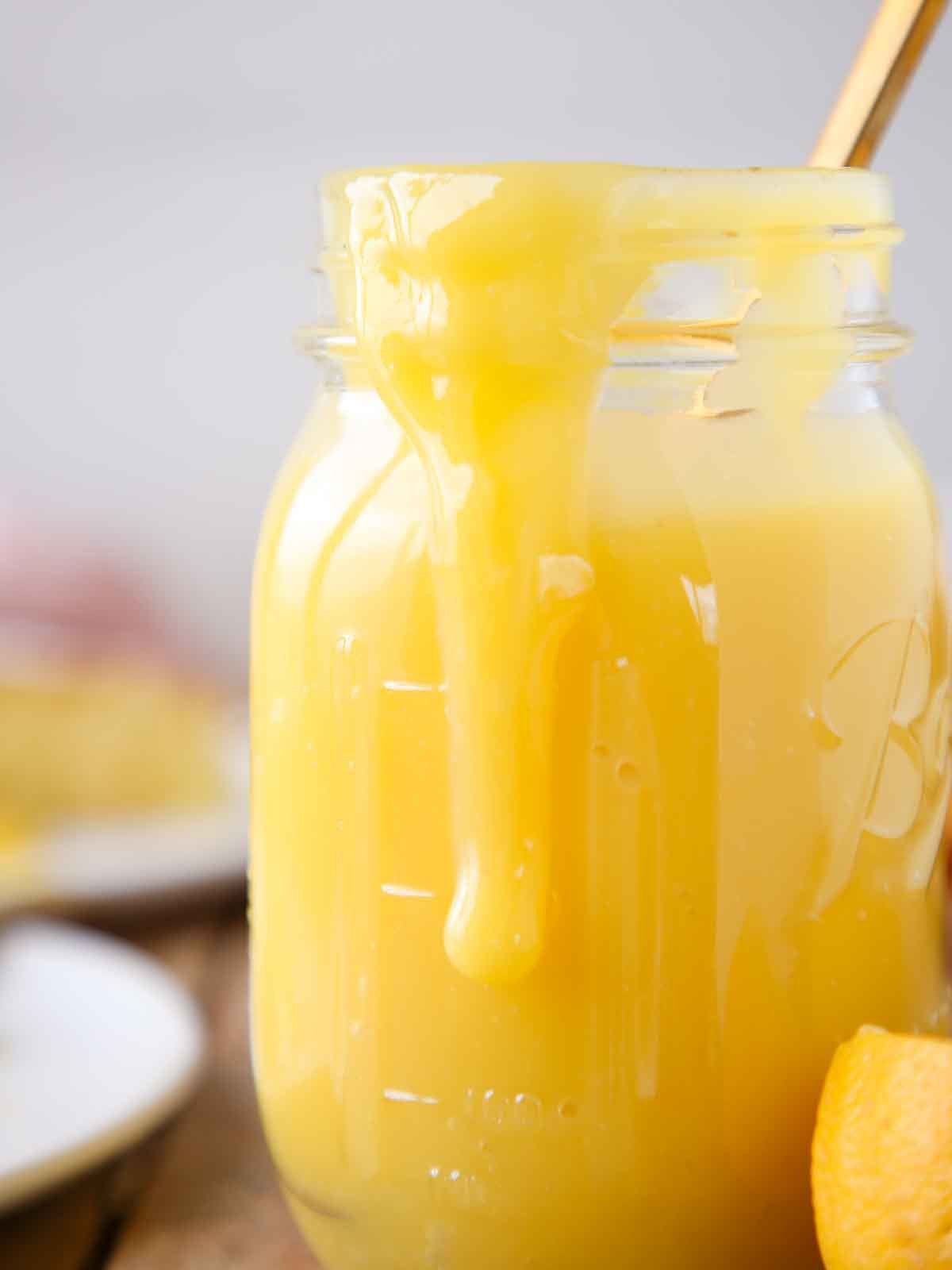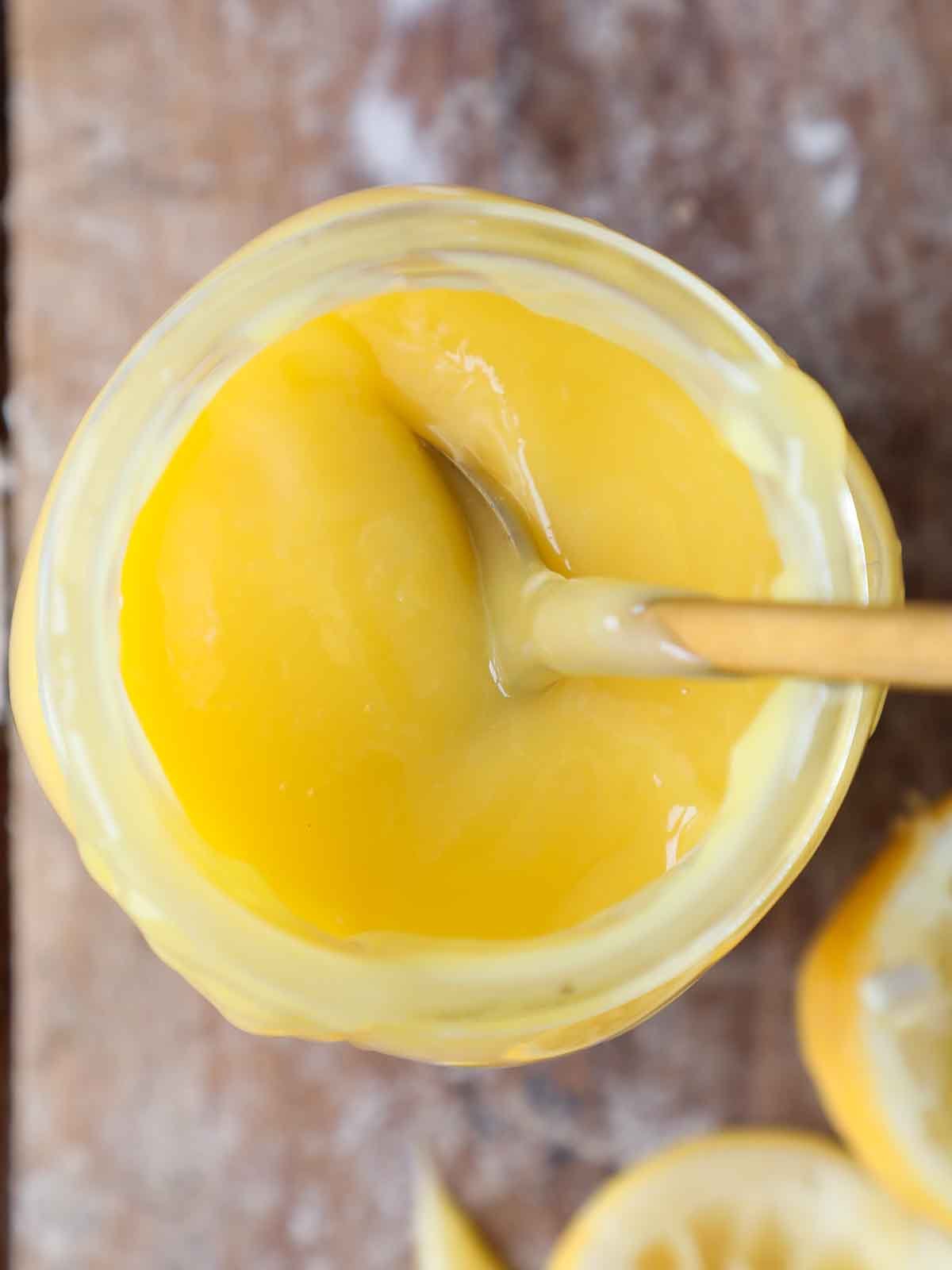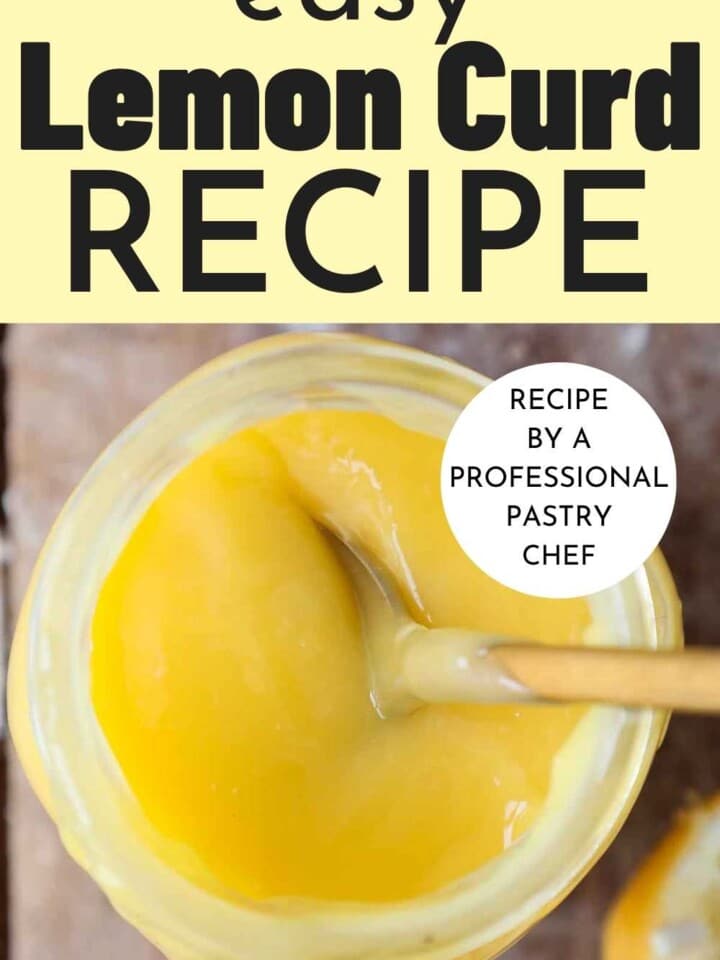This post may contain affiliate links. Please read our disclosure policy.
This smooth, easy lemon curd is refreshingly tart with just a hint of sweetness! A 5-ingredient recipe made on the stovetop and finished with butter for a rich, silky texture. Try using lemon curd to fill cupcakes, serve with cake or flavor anything from buttercream to pudding!

The key to unlocking the perfect lemon curd is the ideal ratio between tart, fresh lemons, sugar and a hint of butter. My lemon curd has just enough sugar to balance the puckering tartness of the lemons but not so much to make it sweet. You want lemon curd to taste like, you guessed it, lemons!
Lemon curd isn’t the sexiest member of the pastry world but it is incredibly versatile! You can use it as a filling for these lemon coconut cupcakes, flavoring Italian Meringue buttercream instead of extract, as a sauce for easy chocolate cake or fruit tarts, with berries and whipped cream on a pavlova cake, or just stirred into yogurt for a sweet, semi-healthy dessert. You can also add a bit of gelatin and it becomes a delightful filling for cakes or lemon bars. I’ll give you even more ideas below!
Table of Contents
Why This is the Best Lemon Curd Recipe
- Refreshing tart flavor that tastes like fresh squeezed lemonade. Sugar is essential to thickening lemon curd and it tames and accentuates the lemon flavor, but many lemon curd recipes are cloyingly sweet and one note. Not this one!
- A pinch of salt and finished with butter for the perfect texture. A pinch of salt heightens the lemon flavor without adding sweetness and finishing with butter makes this lemon curd satiny with a little richness. It’s the same idea as finishing my butterscotch pudding with just a little butter.
- Perfected by a pastry chef in a professional kitchen. This recipe has stood the test of time. It is just as delicious today as it was the first time I used it on the pastry menu at Restaurant Marc Forgione in 2016!


Professional Tips for Making Lemon Curd
- Whisk the eggs and egg yolks well before you add any other ingredients. The egg whites protect the yolks from denaturing when they come in contact with sugar or an acid. Whisk in the sugar next, which will further protect the egg from the intensity of the lemon juice. This will help ensure a smooth lemon curd.
- Don’t stop stirring and get those corners! I have a very specific way to stir lemon curd (and chocolate pudding) to ensure no lumps form on the bottom or edges. Make a zigzag pattern across the whole bottom of the pot then do one circle around the outside edge of the pot with your silicone spatula. Repeat. It’s actually really soothing.
- Switch to the whisk when it starts to curd. Don’t panic when curds start to form. That is the whole point! I switch to a whisk once it begins curding and that keeps it smooth while it thickens. Don’t neglect the corners though!
- You can make the whole thing over a water bath for a hands-off method! It will take 3x as long, but it requires minimal effort on your part. Just an occasional stir and then a whisk once it begins to curd. I used this method in the restaurant when I had a lot of other hand-on preparations.
Ingredients & Substitutions

- Large Eggs & Egg Yolks: When eggs & egg yolks are combined with sugar and an acid like lemon juice and then heated they will thicken. Lemon curd is a stirred custard like vanilla pudding, vanilla pastry cream, crème anglaise, or even chocolate ice cream! Be sure you are using large eggs, oftentimes the yolks are larger in extra large eggs.
- Granulated Sugar: Sugar is essential to the success of this recipe. It helps curd the eggs when combined with the acidic lemon juice. I balance the flavor with the function. You can probably reduce it safely to ¾ cup.
- Lemon Juice: It is worth squeezing fresh lemons for this recipe. Fresh lemon juice has a brightness and floral notes that bottled lacks. Bottled lemon juice is dull and the flavor is flat. The acidity is also essential to the curding property, so you can substitute an acidic puree like passionfruit puree for passionfruit curd or a combination of orange juice and lemon juice for orange curd. Grapefruit juice also works but maybe not ruby red grapefruits. I don’t use the lemon zest because then you must strain the curd.
- Kosher Salt: The kosher salt enhances the flavor without adding sweetness.
- Unsalted Butter: You can omit the butter for a dairy free option. It will still be delicious and smooth. The butter adds a richness and silky mouthfeel.
See the recipe card for full information on ingredients and quantities.
How to use lemon curd
- Uses it as a flavoring. Add lemon curd to vanilla pudding, crème brûlée, vanilla ice cream or pastry cream for a bright lemon option. Use it to flavor buttercream like this Swiss meringue buttercream like I did on this American Flag Cake, Italian meringue buttercream or even to heighten the flavor of this easy lemon buttercream. You can even fold it into whipped cream for a lemon curd whipped cream!
- Use it as a filling. Fill a layer cake (with a dam of frosting to hold it in place), use it as a filling for cupcakes like these unexpected lemon chocolate cupcakes or my lemon cupcakes, or in a berry trifle! It also makes an excellent filling for thumbprint cookies or chocolate thumbprints!
- Spoon it on for an easy dessert or breakfast. Lemon curd is delightful swirled into Greek yogurt or lemon posset. I would be lying if I said I didn’t enjoy a large spoonful in mine while photographing! You can serve it with strawberry scones, blueberry scones, muffins, english muffins, buttermilk biscuits, toast or moist banana bread! It also makes a great topping for pancakes or waffles!
- It makes an excellent sauce! Lemon curd was one of my favorite dessert garnishes when I was an Executive pastry chef in Manhattan restaurants. It adds a bright color, complimentary tart flavor and balances so many different desserts. It can add a smooth contrast to a crunchy component like streusel! Try it with angel food cake, strawberry cake, classic white cake, buttermilk panna cotta, or lemon olive oil cake. Surprise and delight your guests by serving it with this easy one bowl carrot cake or any of my other cake recipes.
- Add gelatin for a more stable curd. Use lemon curd with gelatin in lemon bars, stabilized lemon curd whipped cream, lemon meringue pie filling, or as a more firm filling for cakes. Add the bloomed gelatin to the hot lemon curd after the butter!
- Fill a tart shell. You can use lemon curd with or without gelatin. If you choose not to stabilize, it will not hold a firm slice like lemon meringue pie. Blind bake a tart shell using my pâte sucrée recipe or all-butter pie crust recipe and fill it up! Top with fruit and whipped cream.
- Want the official list? Check out these curated Recipes with Lemon Curd!
How to Make Homemade Lemon Curd
Use these instructions to make silky, smooth lemon curd every time! Further details and measurements can be found in the recipe card below.
Step 1: In a large saucepan, whisk together whole eggs and yolks until smooth and homogenous. There should be no streaks of whites.
Step 2: Whisk in the sugar and salt very well.
Step 3: Slowly whisk in the lemon juice.


The order of incorporation is important here. Whisking the eggs first breaks apart the proteins and separates the yolks. This protects the yolks from denaturing in the presence of sugar or the acidic lemon juice. The sugar further protects the eggs when adding the lemon juice. Denatured egg proteins creates tiny lumps that will not come out except by a very fine mesh sieve.
Step 4: Cook over medium low heat, stirring constantly until nappant or when the custard coats the back of a spoon and will hold a line drawn through with your finger. First all the tiny bubbles will disappear and then it will begin to thicken. When the lemon curd begins to thicken (or curd) you can switch to the whisk briefly to break up those initial clumps and encourage the custard to stay smooth. The consistency will be that of pudding.


Nappant is the French pastry term for the final stage of a stirred custard when you can dip a spoon or spatula into the custard and draw a line across it with your finger and the custard does not run down the spoon into the line.
Step 5: Remove from heat and stir or whisk in butter.
Step 6: Pour into a large bowl or a plastic wrap lined baking sheet. Cover with a piece of plastic wrap directly on the surface, poke a few holes and refrigerate until cold.


You don’t need to strain the curd unless you have lumps. If you do, don’t stress. Simply strain the hot lemon curd through fine mesh sieve before cooling. You can strain it when it is cold, but dang is it harder!
Step 7: Transfer cooled curd to a clean mason jar or airtight container.
Chef Lindsey’s Recipe Tip
For a lemon curd that will set soft, yet firm enough to slice when cold, add 2 sheets of silver gelatin to the this recipe. You could also use 1 tablespoon (1 packet) powdered gelatin. Both the sheets and the powdered gelatin need to be bloomed in cold water before adding to the hot curd.
Frequently Asked Questions
Store cooled lemon curd in a glass mason jar or another airtight container for up to 1 month in the refrigerator or frozen for 3 months.
You can freeze lemon curd. Lemon curd that has been stabilized with gelatin will thaw better. The gelatin helps it maintain it’s structure even when reheated. Reheat frozen lemon curd in a bowl over a pot of simmering water. Stir frequently to ensure even melting. Whisk to make it smooth. If your lemon curd does not have gelatin, take care not to heat it too hot. Just enough to melt it, then whisk to recombine.
I have made this recipe in 12 quart batches. You are only limited by the size of your pot and your patience!
If you tried this recipe and loved it please leave a 🌟 star rating and let me know how it goes in the comments below. I love hearing from you; your comments make my day!

Easy Lemon Curd
Ingredients
- 4 large eggs
- 5 egg yolks
- 1 ⅓ cups granulated sugar
- 1 ¼ cup lemon juice from about 6 large lemons
- ¼ teaspoon kosher salt
- 7 tablespoons unsalted butter cubed
Instructions
- In a large sauce pot, whisk together eggs and yolks until smooth and homogenous.
- Whisk in sugar and salt very well.
- Slowly whisk in the lemon juice.
- Cook over medium heat, stirring constantly until nappant. Nappant is when you can dip a spoon or spatula into the custard and draw a line across it with your finger and the custard does not run down the spoon into the line.
- Remove from heat and stir in butter.
- Strain into a bowl or a plastic wrap lined baking sheet. Cover with plastic wrap, poke a few holes and refrigerate until cold.
Video
Notes
Nutrition
Before You Go
I hope you enjoyed this professional chef tested recipe. You will also love our other custard recipes or more lemon recipes, or try this lemon curd with a slice of lemon pound cake!















This is insanely good!! Made this for cupcakes, hope it lasts to fill them and doesn’t get eaten first!
Hi Kimberly! The eternal struggle! Thanks for coming back to comment, this is an incredible cupcake filling choice.
Hi Chef Lindsay, You are as cute as can be and I love your blog that I just wandered into looking for a lemon curd recipe to compare mine to. My lemon curd is delicious as well but it was created for folks with IBS who have to be careful about what they eat. There is no way IBS folks could eat yours (sob!) It contains too many egg yolks; however, you did go easy on the butter. Ina puts in enough butter to send my viewers to the loo for a week. Anyway, I love your peppy style and I am glad you are getting back to doing what you love – making pastry.
Hi Joan! That sounds like a wonderful recipe, I love that folks who have different restrictions can still enjoy the deliciousness that is Lemon Curd. Thank you so much for taking the time to write your comment, it was really meaningful to me to read it and know you’re on the journey with me!